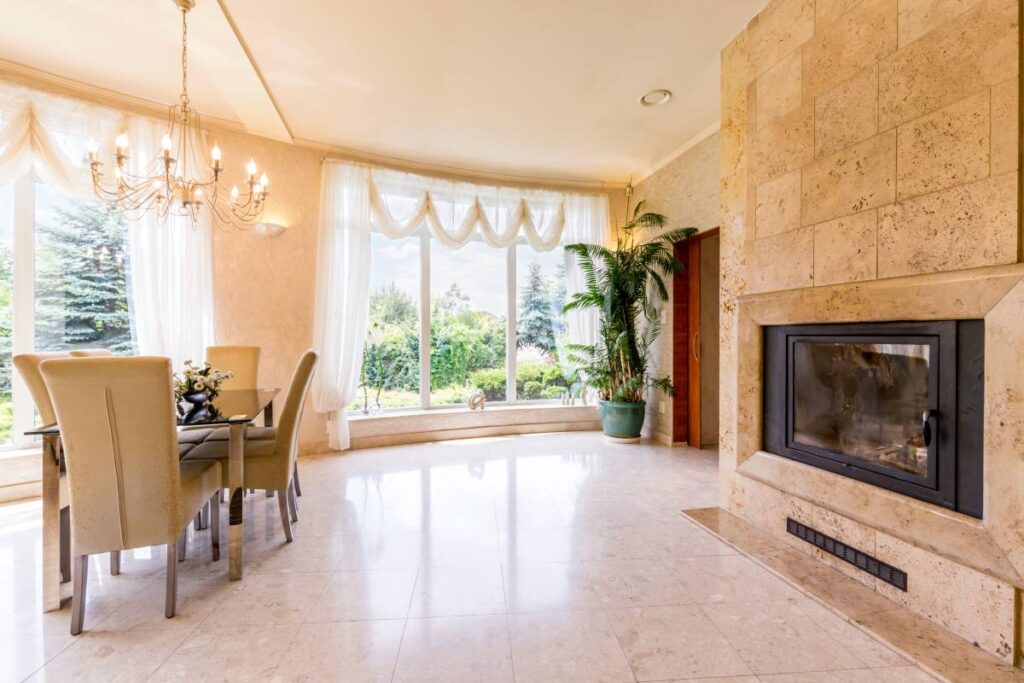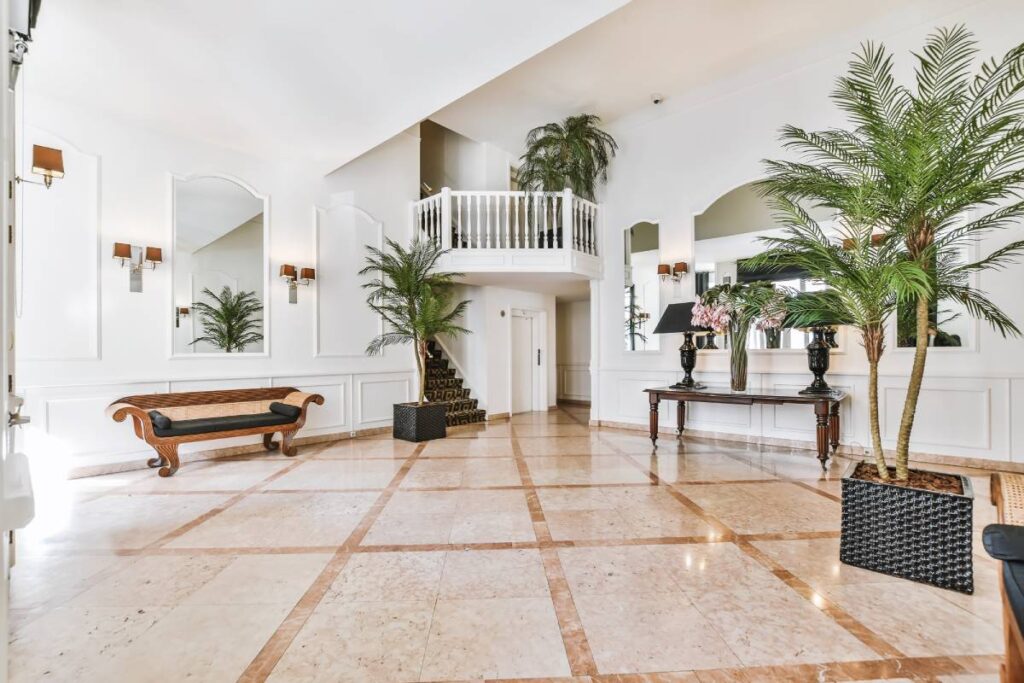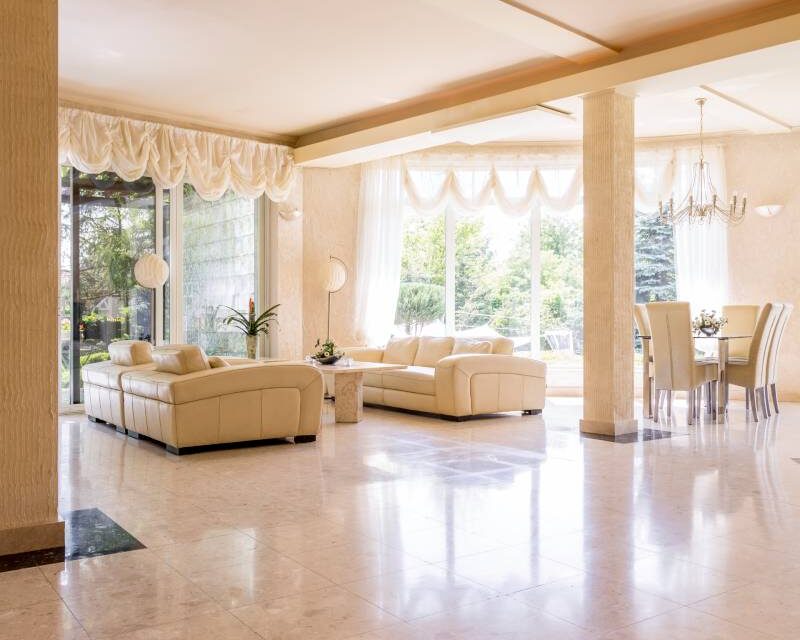When you have a guest invited to your house, the first thing they will see outside your house might be your yard, roof, paint, plantation shutters, etc.
But when guests step into your home, what catches their eye first are the walls, ceiling, and flooring—the key trio of interior design. Surprisingly, flooring often gets less attention despite being the foundation of your home. Choosing the right flooring material is vital for creating a stunning home, and that’s where granite flooring shines.
Is granite good for flooring?
So, Is granite good for flooring? You might ask, and the answer is YES!
Granite is widely regarded as an exceptional flooring material, offering a blend of durability, aesthetics, and practicality that makes it a popular choice for homeowners and designers alike. As a natural stone, granite possesses inherent strength and hardness, making it highly resistant to wear and tear from daily foot traffic. This durability ensures that granite flooring maintains its integrity and appearance even in high-traffic areas, such as kitchens, hallways, and entryways, where other flooring materials might show signs of wear over time.
One of the key advantages of granite flooring is its remarkable resistance to scratches and stains. Unlike some other flooring options, granite is not easily damaged by furniture movement, pet claws, or dropped objects, making it an ideal choice for households with active lifestyles or pets. Additionally, granite’s resistance to moisture and spills makes it suitable for use in areas prone to spills or water exposure, such as bathrooms and kitchens. Properly sealed granite flooring provides an added layer of protection against moisture penetration, helping to maintain its longevity and appearance for years to come.
In addition to its practical benefits, granite flooring offers a wide range of aesthetic possibilities. Available in an array of colours, patterns, and finishes, granite allows homeowners to choose a flooring option that complements their interior design style and preferences. Whether opting for a classic, timeless look with neutral tones or making a bold statement with vibrant hues and striking patterns, granite flooring provides endless possibilities for customization and creativity.
While granite flooring offers numerous advantages, it’s essential to consider proper maintenance to ensure its longevity and beauty. Regular cleaning and sealing are necessary to protect the surface from stains, spills, and moisture infiltration. With proper care, granite flooring can remain a stunning and durable addition to any home for years to come, providing both practicality and aesthetic appeal that stands the test of time.

Are granite floors expensive?
Granite flooring can be relatively expensive compared to some other flooring options, but its cost can vary depending on several factors. The price of granite flooring is influenced by factors such as the quality of the granite, the size of the area to be covered, installation costs, and any additional customization or finishing options.
Let’s see how much granite flooring might cost you.
Estimating the cost of installing granite tile flooring
Granite flooring tile installation typically ranges from $300 to $5,000. For most homeowners, the average cost falls between $600 and $2,500. The final price depends on factors like the size of the area, the quality and type of granite chosen, and the complexity of the project. Many professionals offer a free consultation, but for very small projects, they may require a minimum fee of $300 to $500.
The cost breakdown generally includes both materials and labour. Premium-grade granite tiles can increase material costs, while larger tiles or expansive flooring areas can drive up labour expenses. Overall, granite tile flooring tends to be pricier compared to ceramic tiles and other flooring options.
Labour costs for installing granite floor tiles typically range from $35 to $45 per hour for natural stone flooring contractors. The total hours required depend on the size and intricacy of the job. For example, a standard 10-by-10 square foot granite tile floor usually takes around 10 hours to complete, amounting to labour costs of approximately $350 to $450. However, larger or more complex tile placements may increase this expense. Additionally, labour costs should cover necessary supplies like sealant, grout, and adhesives for the project.
Factors affecting the cost of installing granite tile flooring
Several factors influence the overall cost of installing granite tile flooring. Granite comes in various styles, shapes, and thicknesses, and each flooring project has its unique installation requirements.
Grade Granite is typically categorized into three grades, each with its own characteristics and cost range:
- Level 1 (Low-Grade Granite): Priced at $2 to $6 per square foot, these entry-level granite tiles are usually pre-fabricated and have a thinner cut of around three-eighths of an inch. While easier to install, they may require additional support such as plywood due to their lighter form.
- Level 2 (Mid-Grade Granite): These medium-tier tiles range from $5 to $15 per square foot and offer both a unique appearance and increased durability, with a thickness of about three-fourths of an inch. They constitute the most common type of granite tiles used for flooring.
- Level 3 and Above (High-Grade Granite): The finest quality granite, costing $15 to $40 per square foot, features an average thickness of three-fourths of an inch or more. High-grade granite is exceptionally durable and offers a wide range of unique designs and colour patterns.

Specialized colours and designs
Granite tiles are available in various colours and designs, with prices for unique options ranging from $10 to $40 per square foot. Special colours or finishes can increase the overall cost. Additionally, granite flooring comes in different finishes, including polished, honed, flamed, and brushed.
Custom borders and inlays
Adding custom borders or inlays to granite tile flooring incurs extra costs. Custom orders typically range from $200 to $600 for a 10-by-10-square-foot area, while large stone inlays like medallions can cost $600 to $3,000, depending on size and materials used.
Diagonal vs. straight installation
Granite tiles can be installed straight or diagonally, with diagonal installation typically incurring a labour uptick of around ten per cent due to the additional complexity of cutting tiles at 45-degree angles.
Flooring size
The size of the flooring space is a significant cost factor, with larger areas requiring more materials and labour. Many homeowners opt to use granite in smaller, high-traffic areas like foyers or hallways to create an impressive entrance while managing costs.
Additional factors influencing granite tile flooring installation costs
Several extra expenses and considerations may arise for homeowners, depending on the specifics of the project.
Floor preparation and furniture removal
Granite tiles cannot be installed directly over existing flooring. Costs for removing old tile flooring typically range from $2 per square foot, while replacing any necessary backer boards can cost between $5 to $8 per square foot. Additionally, resurfacing an uneven concrete subfloor may incur expenses of $3 to $10 per square foot. Furniture removal and replacement by a professional typically add around $0.20 per square foot to the overall cost, although homeowners can opt to move the furniture themselves before installation.
Sealing
While granite is highly durable, it is vulnerable to staining. To protect against stains, professionals apply a heavy-duty sealant after laying the tiles. This step may be included in the initial estimate, but if not, expect additional costs of $50 to $100 for materials and labour. Yearly reapplication of sealant is recommended for optimal protection. Homeowners can choose to purchase sealant themselves, priced between $15 to $50 per container, and perform the sealing process independently to save on costs.
Material delivery
Granite tiles are heavy and can be challenging to transport. Home delivery typically incurs fees ranging from $50 to $150, an aspect to consider for DIY projects. However, reputable flooring experts often include material delivery as part of their service at no extra charge.
DIY versus professional installation
Taking on the installation yourself can save $350 to $450, but it carries certain risks. Granite tiles are heavy and require precise installation techniques to avoid damage. Unless experienced with tile flooring and natural stones, it’s generally advisable to hire a professional to ensure proper measurements and installation. Poor workmanship can detract from the floor’s overall aesthetic appeal, potentially leading to costly repairs.

Are there any disadvantages of granite flooring?
While granite flooring offers numerous benefits, there are also some potential disadvantages to consider:
- Cost: Granite flooring can be relatively expensive compared to other flooring options such as ceramic tiles or vinyl. The initial investment for materials and installation may be higher, which could be a drawback for those with budget constraints.
- Weight: Granite tiles are heavy, which can make handling and installation more challenging. This weight may require additional structural support in some cases, especially for upper floors or existing buildings not designed to bear such loads.
- Porosity: Despite its durability, granite is a porous material, which means it can absorb liquids if not properly sealed. This makes it susceptible to staining from spills if not maintained and sealed regularly.
- Coldness: Granite flooring can feel cold underfoot, especially in colder climates or during winter months. While this might not be an issue for some, it could be uncomfortable for those who prefer warmer flooring surfaces.
- Hardness: While granite’s hardness is a benefit in terms of durability, it can also be a drawback in terms of comfort. Standing on granite for extended periods, especially without supportive footwear, may lead to discomfort or fatigue.
- Maintenance: While granite is relatively low-maintenance compared to some other flooring materials, it still requires regular cleaning and sealing to preserve its appearance and longevity. Failure to maintain granite flooring properly could lead to deterioration or staining over time.
- Limited Design Options: While granite comes in a variety of colours and patterns, natural stone may not offer as much versatility in design compared to some synthetic flooring materials. This limitation could be a drawback for those seeking highly customized or unique flooring options.
Considering these potential disadvantages alongside the benefits of granite flooring can help homeowners make informed decisions about whether it’s the right choice for their needs and preferences.
Final note
When opting for granite flooring, it’s crucial to pick the appropriate finish based on whether it’s for indoor or outdoor use. For outdoor spaces like terraces, durability and slip resistance are key due to exposure to sun, rain, and frost. A flamed finish granite is ideal here, creating a slightly rough surface with a glazed appearance, perfect for outdoor durability.
For outdoor granite floors, opt for colours like grey or cream to minimize stains, as non-slip textures tend to gather dirt more easily.
Indoors, polished and smooth matt finishes are recommended for granite floors as there’s no risk of slipping. These finishes enhance the natural beauty of the stone, adding brightness and elegance to spaces like kitchens or living rooms. Cleaning indoor granite floors is simple—just use water and a neutral detergent.



